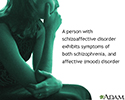Schizoaffective disorder
Mood disorder - schizoaffective disorder; Psychosis - schizoaffective disorder
Schizoaffective disorder is a mental condition that causes both a loss of contact with reality (psychosis) and mood problems (depression or mania).
Causes
The exact cause of schizoaffective disorder is unknown. Changes in genes and chemicals in the brain (neurotransmitters) may play a role.
Schizoaffective disorder is thought to be less common than schizophrenia and mood disorders. Women may have the condition more often than men. Schizoaffective disorder is rare in children.
Symptoms
Symptoms of schizoaffective disorder are different in each person. Often, people with schizoaffective disorder seek treatment for problems with mood, daily function, or abnormal thoughts.
Psychosis and mood problems may occur at the same time or by themselves. The disorder may involve cycles of severe symptoms followed by improvement.
The symptoms of schizoaffective disorder can include:
- Changes in appetite and energy
- Disorganized speech that is not logical
- False beliefs (delusions), such as thinking someone is trying to harm you (paranoia) or thinking that special messages are hidden in common places (delusions of reference)
- Lack of concern with hygiene or grooming
- Mood that is either too good, or depressed or irritable
- Problems sleeping
- Problems with concentration
- Sadness or hopelessness
- Seeing or hearing things that are not there (hallucinations)
- Social isolation
- Speaking so quickly that others cannot interrupt you
Exams and Tests
There are no medical tests to diagnose schizoaffective disorder. Your health care provider will do a mental health assessment to find out about the person's behavior and symptoms. A psychiatrist may be consulted to confirm the diagnosis.
To be diagnosed with schizoaffective disorder, you must have psychotic symptoms and a mood disorder. In addition, you must have psychotic symptoms during a period of normal mood for at least 2 weeks.
The combination of psychotic and mood symptoms in schizoaffective disorder can be seen in other illnesses, such as bipolar disorder. Extreme disturbance in mood is an important part of schizoaffective disorder.
Before diagnosing schizoaffective disorder, your provider will check for medical and medicine-related conditions. Other mental disorders that cause psychotic or mood symptoms must also be ruled out. For example, psychotic or mood disorder symptoms can occur in people who:
- Use cocaine, amphetamines, or phencyclidine (PCP)
- Have seizure disorders
- Take steroid medicines
Treatment
Treatment can vary. In general, your provider will prescribe medicines to improve your mood and treat psychosis:
- Antipsychotic medicines are used to treat psychotic symptoms.
- Antidepressant medicines, or mood stabilizers, may be prescribed to improve mood.
Talk therapy can help with creating plans, solving problems, and maintaining relationships. Group therapy can help with social isolation.
Support and work training may be helpful for work skills, relationships, money management, and living situations.
Outlook (Prognosis)
People with schizoaffective disorder have a greater chance of going back to their previous level of function than do people with most other psychotic disorders. But long-term treatment is often needed, and results vary from person to person.
Possible Complications
Complications are similar to those for schizophrenia and major mood disorders. These include:
- Substance misuse
- Problems following medical treatment and therapy
- Problems due to manic behavior (for example, spending sprees, overly sexual behavior)
- Suicidal behavior
When to Contact a Medical Professional
Contact your provider if you or someone you know is experiencing any of the following:
- Depression with feelings of hopelessness or helplessness
- Inability to care for basic personal needs
- Increase in energy and involvement in risky behavior that is sudden and not normal for you (for instance, going days without sleeping and feeling no need for sleep)
- Strange or unusual thoughts or perceptions
- Symptoms that get worse or do not improve with treatment
- Thoughts of suicide or of harming others
If you or someone you know is thinking about suicide, call or text 988 or chat 988lifeline.org. You can also call 1-800-273-8255 (1-800-273-TALK). The 988 Suicide and Crisis Lifeline provides free and confidential support 24/7, anytime day or night.
You can also call 911 or the local emergency number or go to the hospital emergency room. DO NOT delay.
If someone you know has attempted suicide, call 911 or the local emergency number right away. DO NOT leave the person alone, even after you have called for help.
References
American Psychiatric Association website. Schizophrenia spectrum and other psychotic disorders. Diagnostic and Statistical Manual of Mental Disorders. 5th ed. Text Revision (DSM-5-TR), Washington, DC: American Psychiatric Association Publishing; 2022.
Lim C, Paudel S, Holt D, Freudenreich O. Psychosis and schizophrenia. In: Stern TA, Wilens TE, Fava M, eds. Massachusetts General Hospital Comprehensive Clinical Psychiatry. 3rd ed. Philadelphia, PA: Elsevier; 2025:chap 27.
Lyness JM, Lee HB. Psychiatric disorders in medical practice. In: Goldman L, Cooney KA, eds. Goldman-Cecil Medicine. 27th ed. Philadelphia, PA: Elsevier; 2024:chap 362.
Review Date: 5/4/2024







